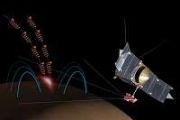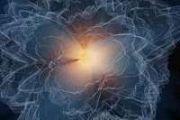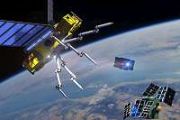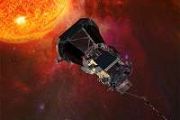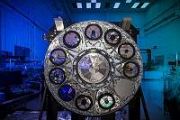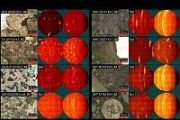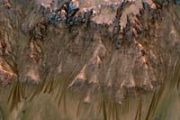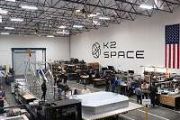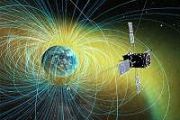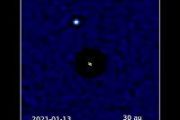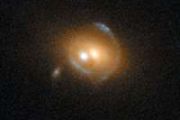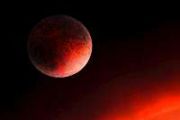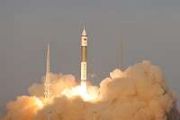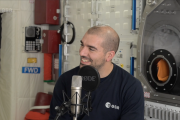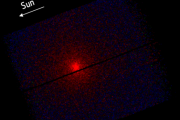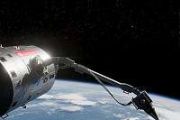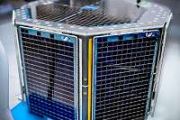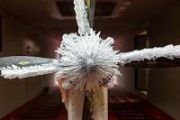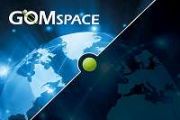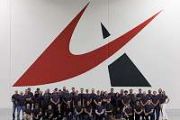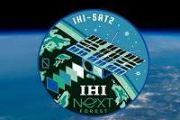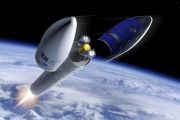
Copernical Team
Integral's 20th anniversary
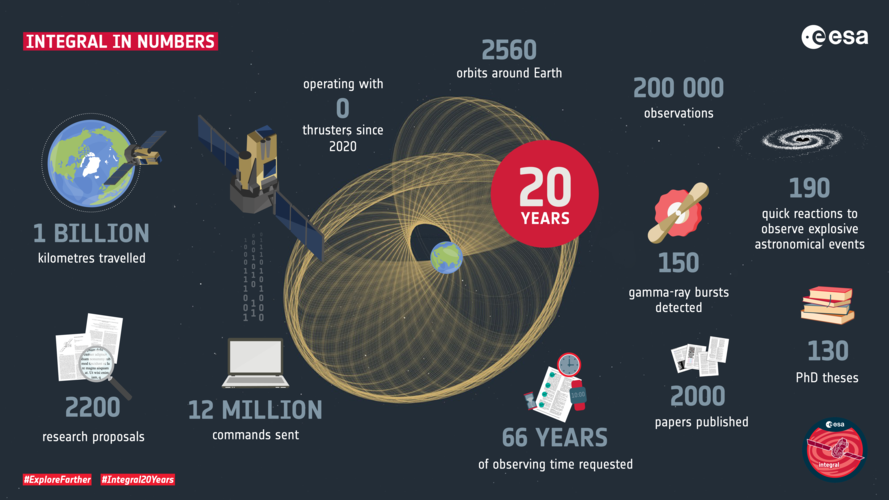 Image:
Image:
Launched on 17 October 2002, ESA’s Integral mission is a world-class mission which has been observing the Universe’s violent explosions and powerful phenomena for 20 years, achieving many scientific firsts. The mission's impressive lifetime is owed to responsibility and leadership on the side of ESA science and operations. This graphic highlights some of the mission’s impressive numbers to date.
Arecibo Observatory in Puerto Rico will not be rebuilt
 The National Science Foundation said Friday that it won't rebuild the Arecibo Observatory in Puerto Rico, and instead pans to build a STEM-focused education center.
The center would expand upon existing education and outreach opportunities, and is expected to open in 2023, the NSF said in a statement.
The NSF is soliciting proposals to manage "the education, STEM research, and ou
The National Science Foundation said Friday that it won't rebuild the Arecibo Observatory in Puerto Rico, and instead pans to build a STEM-focused education center.
The center would expand upon existing education and outreach opportunities, and is expected to open in 2023, the NSF said in a statement.
The NSF is soliciting proposals to manage "the education, STEM research, and ou NASA's Swift, Fermi missions detect exceptional cosmic blast
 Astronomers around the world are captivated by an unusually bright and long-lasting pulse of high-energy radiation that swept over Earth Sunday, Oct. 9. The emission came from a gamma-ray burst (GRB) - the most powerful class of explosions in the universe - that ranks among the most luminous events known.
On Sunday morning Eastern time, a wave of X-rays and gamma rays passed through the so
Astronomers around the world are captivated by an unusually bright and long-lasting pulse of high-energy radiation that swept over Earth Sunday, Oct. 9. The emission came from a gamma-ray burst (GRB) - the most powerful class of explosions in the universe - that ranks among the most luminous events known.
On Sunday morning Eastern time, a wave of X-rays and gamma rays passed through the so Blue Skies Space satellite will monitor how energy released by stars impacts exoplanet habitability
 Stars, including our own Sun, can release huge amounts of energy during outbursts called flares. The most intense ones pose a danger to modern society through disruption to electricity grids, satellite systems and the Earth's climate. Blue Skies Space's new satellite Mauve is designed to monitor the flaring activity of stars that are hosts to potentially habitable exoplanets (planets outside our
Stars, including our own Sun, can release huge amounts of energy during outbursts called flares. The most intense ones pose a danger to modern society through disruption to electricity grids, satellite systems and the Earth's climate. Blue Skies Space's new satellite Mauve is designed to monitor the flaring activity of stars that are hosts to potentially habitable exoplanets (planets outside our Heaviest element yet detected in an exoplanet atmosphere
 Using the European Southern Observatory's Very Large Telescope (ESO's VLT), astronomers have discovered the heaviest element ever found in an exoplanet atmosphere - barium. They were surprised to discover barium at high altitudes in the atmospheres of the ultra-hot gas giants WASP-76 b and WASP-121 b - two exoplanets, planets which orbit stars outside our Solar System. This unexpected discovery
Using the European Southern Observatory's Very Large Telescope (ESO's VLT), astronomers have discovered the heaviest element ever found in an exoplanet atmosphere - barium. They were surprised to discover barium at high altitudes in the atmospheres of the ultra-hot gas giants WASP-76 b and WASP-121 b - two exoplanets, planets which orbit stars outside our Solar System. This unexpected discovery NASA studies origins of dwarf planet Haumea
 Using computer simulations, scientists based at NASA have pieced together the story of how the dwarf planet Haumea, found in the Kuiper Belt of icy worlds beyond the orbit of outermost planet Neptune, became one of the most unusual objects in the solar system.
Nearly the size of Pluto, Haumea is strange in several ways. It spins faster, by far, than anything else of its size, whirling on i
Using computer simulations, scientists based at NASA have pieced together the story of how the dwarf planet Haumea, found in the Kuiper Belt of icy worlds beyond the orbit of outermost planet Neptune, became one of the most unusual objects in the solar system.
Nearly the size of Pluto, Haumea is strange in several ways. It spins faster, by far, than anything else of its size, whirling on i Things that go bump in the night on Mars!
 You stand in Jezero crater, Mars, at a minute to midnight. By the light of the stars and Mars's two tiny moons, Phobos and Deimos, you can just make out the shape of the looming delta. Nothing moves; the wind tonight is too low to even push a sand grain over. All is peaceful and quiet. Then, out of nowhere, comes an alien, mechanical whirring noise... and a misshapen head rises up out of the dar
You stand in Jezero crater, Mars, at a minute to midnight. By the light of the stars and Mars's two tiny moons, Phobos and Deimos, you can just make out the shape of the looming delta. Nothing moves; the wind tonight is too low to even push a sand grain over. All is peaceful and quiet. Then, out of nowhere, comes an alien, mechanical whirring noise... and a misshapen head rises up out of the dar Asteroid sample return mission on track for Fall '23 Delivery
 NASA's first asteroid sample return spacecraft, OSIRIS-REx, fired its thrusters for 30 seconds on Sept. 21 and nudged its trajectory toward Earth. The resulting course correction keeps the vehicle on track to deliver a sample of asteroid Bennu to Earth on Sept. 24, 2023, completing a seven-year mission.
The delivery itself, however, is not a simple parcel drop on Earth's front doorstep: NA
NASA's first asteroid sample return spacecraft, OSIRIS-REx, fired its thrusters for 30 seconds on Sept. 21 and nudged its trajectory toward Earth. The resulting course correction keeps the vehicle on track to deliver a sample of asteroid Bennu to Earth on Sept. 24, 2023, completing a seven-year mission.
The delivery itself, however, is not a simple parcel drop on Earth's front doorstep: NA NASA Crew-4 astronauts safely splash down in Atlantic
 NASA's SpaceX Crew-4 astronauts aboard the Dragon spacecraft safely splashed down Friday off the coast of Jacksonville, Florida, completing the agency's fourth commercial crew mission to the International Space Station. The international crew of four spent 170 days in orbit.
NASA astronauts Bob Hines, Kjell Lindgren, and Jessica Watkins and ESA (European Space Agency) astronaut Samantha Cr
NASA's SpaceX Crew-4 astronauts aboard the Dragon spacecraft safely splashed down Friday off the coast of Jacksonville, Florida, completing the agency's fourth commercial crew mission to the International Space Station. The international crew of four spent 170 days in orbit.
NASA astronauts Bob Hines, Kjell Lindgren, and Jessica Watkins and ESA (European Space Agency) astronaut Samantha Cr Musk says cannot fund Starlink in Ukraine indefinitely
 Elon Musk said Friday that SpaceX would not be able to pay for Starlink satellite internet in Ukraine indefinitely, while the US military confirmed it was communicating with the billionaire's company about funding for the key network.
The discussions come as Musk has been embroiled in public spats with Ukrainian leaders who were angered by his controversial plan for de-escalating the conflic
Elon Musk said Friday that SpaceX would not be able to pay for Starlink satellite internet in Ukraine indefinitely, while the US military confirmed it was communicating with the billionaire's company about funding for the key network.
The discussions come as Musk has been embroiled in public spats with Ukrainian leaders who were angered by his controversial plan for de-escalating the conflic 
